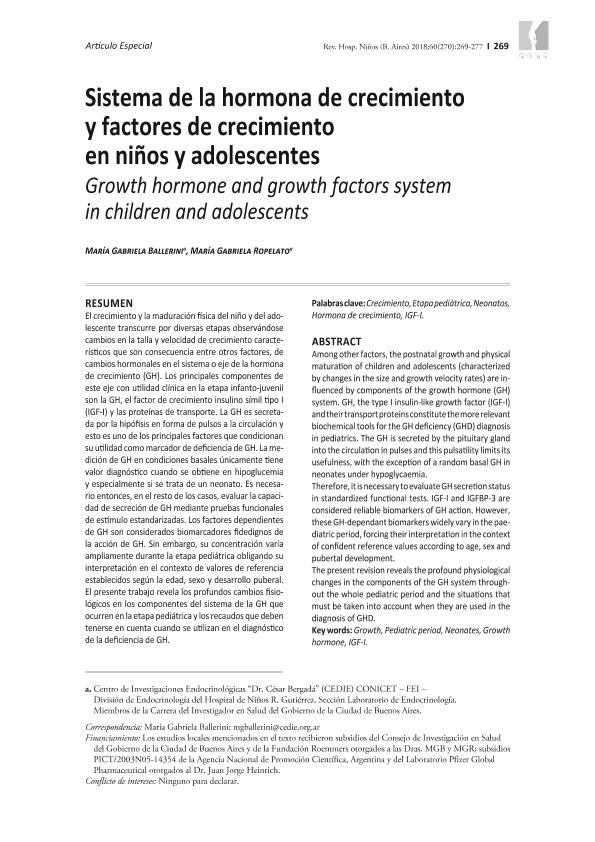Artículo
El crecimiento y la maduración física del niño y del adolescente transcurre por diversas etapas observándose cambios en la talla y velocidad de crecimiento característicos que son consecuencia entre otros factores, de cambios hormonales en el sistema o eje de la hormona de crecimiento (GH). Los principales componentes de este eje con utilidad clínica en la etapa infanto-juvenil son la GH, el factor de crecimiento insulino símil tipo I (IGF-I) y las proteínas de transporte. La GH es secretada por la hipófisis en forma de pulsos a la circulación y esto es uno de los principales factores que condicionan su utilidad como marcador de deficiencia de GH. La medición de GH en condiciones basales únicamente tiene valor diagnóstico cuando se obtiene en hipoglucemia y especialmente si se trata de un neonato. Es necesario entonces, en el resto de los casos, evaluar la capacidad de secreción de GH mediante pruebas funcionales de estímulo estandarizadas. Los factores dependientes de GH son considerados biomarcadores fidedignos de la acción de GH. Sin embargo, su concentración varía ampliamente durante la etapa pediátrica obligando su interpretación en el contexto de valores de referencia establecidos según la edad, sexo y desarrollo puberal. El presente trabajo revela los profundos cambios fisiológicos en los componentes del sistema de la GH que ocurren en la etapa pediátrica y los recaudos que deben tenerse en cuenta cuando se utilizan en el diagnóstico de la deficiencia de GH. Among other factors, the postnatal growth and physical maturation of children and adolescents (characterized by changes in the size and growth velocity rates) are influenced by components of the growth hormone (GH) system. GH, the type I insulin-like growth factor (IGF-I) and their transport proteins constitute the more relevant biochemical tools for the GH deficiency (GHD) diagnosis in pediatrics. The GH is secreted by the pituitary gland into the circulation in pulses and this pulsatility limits its usefulness, with the exception of a random basal GH in neonates under hypoglycaemia. Therefore, it is necessary to evaluate GH secretion status in standardized functional tests. IGF-I and IGFBP-3 are considered reliable biomarkers of GH action. However, these GH-dependant biomarkers widely vary in the paediatric period, forcing their interpretation in the context of confident reference values according to age, sex and pubertal development. The present revision reveals the profound physiological changes in the components of the GH system throughout the whole pediatric period and the situations that must be taken into account when they are used in the diagnosis of GHD.
Sistema de la hormona de crecimiento y factores de crecimiento en niños y adolescentes
Título:
Growth hormone and growth factors system in children and adolescents
Fecha de publicación:
09/2018
Editorial:
Asociación de Profesionales del Hospital de Niños Ricardo Gutiérrez
Revista:
Revista del Hospital de Niños de Buenos Aires
ISSN:
0521-517X
e-ISSN:
2314-1239
Idioma:
Español
Tipo de recurso:
Artículo publicado
Clasificación temática:
Resumen
Palabras clave:
Crecimiento
,
Factores de crecimiento
,
Niños
,
Adolescentes
Archivos asociados
Licencia
Identificadores
Colecciones
Articulos(CEDIE)
Articulos de CENTRO DE INVESTIGACIONES ENDOCRINOLOGICAS "DR. CESAR BERGADA"
Articulos de CENTRO DE INVESTIGACIONES ENDOCRINOLOGICAS "DR. CESAR BERGADA"
Citación
Ballerini, Maria Gabriela; Ropelato, Maria Gabriela; Sistema de la hormona de crecimiento y factores de crecimiento en niños y adolescentes; Asociación de Profesionales del Hospital de Niños Ricardo Gutiérrez; Revista del Hospital de Niños de Buenos Aires; 60; 270; 9-2018; 269-277
Compartir




